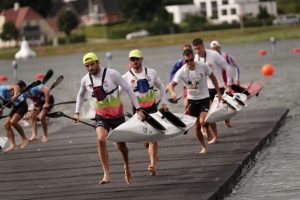I remember long ago being a young paddler and while paddling, my coach would whistle rhythmically to indicate what kind of stroke rate I should be at. Gone are the days of following a whistle or a metronome in a zip-lock bag thrown in the boat. Thanks to some hardworking, very smart people we now have the convenience of a small waterproof device that effortlessly attaches to your paddle, and communicates real-time cadence info directly to your GPS.
Why is this important? Where do I start…
In years past, we have become more and more sophisticated with our devices (thanks again to these hardworking smart people!) and have evolved from the stopwatch to GPS units the size of your watch. These GPS units can give you your current speed, and of course help with navigation by directing you to a fixed way point. In other words, we can pretty much measure any metric out there, from heart rate, to speed or pace, to distance covered, and now of course, cadence.
And you can’t improve what you don’t measure!
Let’s look a little closer at the metrics we can measure (and therefore improve).
Starting with Speed: very useful as it gives you an immediate and actual result of the effort you are putting in. Problems come up when you are training in a body of water that is tidal and has strong currents, and a lot of strong, gusty head/tail winds.
Speed is very useful, but is not always going to be reliable as a testing metric.
Heart Rate: a great measurement of the intensity of the work you are doing. This is especially true at lower intensity work (think recovery and aerobic endurance) and a great way to make changes to your anaerobic threshold. Once we get into maximum speed type of work though, heart rate is going to become irrelevant.
So how do we go faster?
To improve your boat speed you need to either increase stroke rate (therefore the number of strokes taken) or increase the distance traveled with each stroke. Is it really that simple? I wish!
Coaching is both an art and a science, as I am sure you have heard before. Knowing all the right ingredients, and where and how to place them into the “recipe” will help you achieve that successful end product.
When we are talking specifically about how to improve you paddling speed, as a neuromuscular skill, the cadence sensor comes into a league of its own.
Stroke rate as an analytical tool
Have you ever noticed that when you try speed up for the end of an interval or race, and your rate goes up but you stay the same speed, or worse, you slow down? This is a direct indicator that you are in need of some technique assistance. Using the Vaaka as a technique analysis tool is a great way to make major improvements in you paddling stroke.

Choosing the correct paddle can also be broken down using the Vaaka and some basic testing and analytics.
Stroke rate as a zone setter
Setting your training zones using stroke rate as the defining metric is a truly simple, yet effective way to determine training zone intensities. It is also a great way to identify stroke inefficiencies, for example when a group of athletes are working in the same zone, but are end up travelling at different speeds, we have some inefficiencies.
Early in the season, when one of our main goals is improved aerobic endurance, we can use a simple test like paddling a set distance, at a set cadence, and taking note of the resulting heart rate and heart rate recovery. In this way, keeping some of the test parameters the same, we can monitor our paddlers for a change in performance over time (and therefore see if our training is paying off in the right direction!)
Training with a cadence sensor
We send so much time training with improved fitness in mind, but how do we train to become faster?
Winter is an excellent time to be working on efficiency. With the next few blocks of training dedicated to becoming a stronger, more efficient paddler, you are going to become fitter as a result and most importantly faster!
If you are interested in learning more about training with cadence, please reach out to us directly on info@threeoceans.co to book a consult, as well as follow our blog or sign up for our newsletter!






